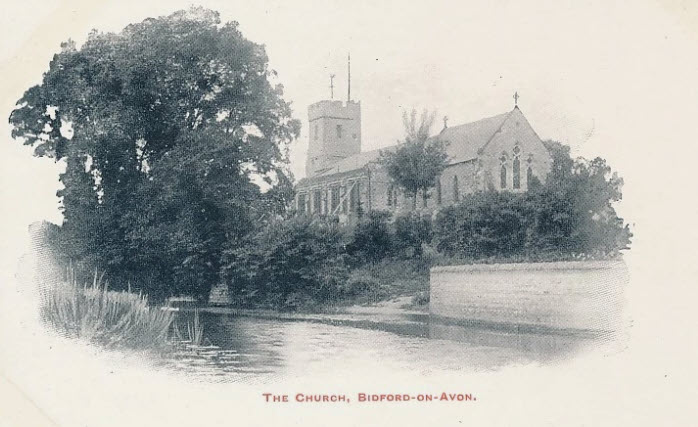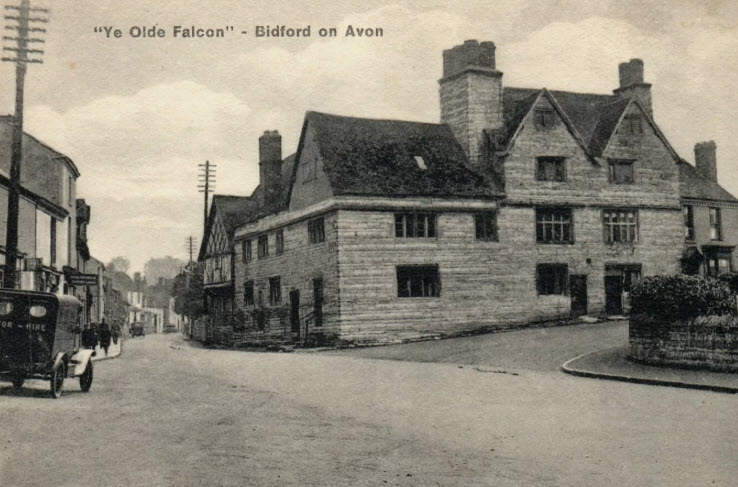

The History of Bidford-on-Avon, Warwickshire
Overview
Bidford-on-Avon is a historic village in Warwickshire, England, situated on the banks of the River Avon approximately seven miles southwest of Stratford-upon-Avon. The village’s strategic location at a river crossing point has shaped its development over more than two millennia, from prehistoric settlements to its current status as a thriving community of over 6,800 residents.
Prehistoric and Roman Origins
Archaeological evidence reveals that human occupation of the Bidford area extends back to the Paleolithic period, over 10,000 years ago, with stone tools discovered by the River Avon. Neolithic activity has been confirmed through excavations that revealed at least one Neolithic pit and various flint artifacts dating to the Neolithic or Bronze Age periods.
The Roman period marked a significant development in Bidford’s history. The important Roman road Icknield Street (also known as Ryknild Street) passed directly through the village, running north towards Alcester and connecting the Fosse Way to Watling Street. This road crossed the River Avon at what became known as “Byda’s Ford” in Anglo-Saxon times, giving the village its name. Roman settlements have been identified through archaeological excavations, including evidence of timber buildings from the 1st to 4th centuries AD. Roman finds, including coins and other artifacts, have been discovered throughout the area, and it is believed there was a Roman villa and market in the vicinity.
Anglo-Saxon Period
The Anglo-Saxon era represents one of the most archaeologically significant periods in Bidford’s history. The village is home to the largest Anglo-Saxon cemetery in the region, first discovered in 1921 when road construction uncovered approximately 23 skeletons. Subsequent excavations in 1922 by the Birmingham Archaeological Society revealed around 80 inhumations and 17 complete cremation urns, along with numerous grave goods including spearheads, knives, shield bosses, brooches, and jewelry dating to the early 6th century.
The cemetery continued to yield important finds through the 20th century, with a 1990 excavation discovering 17 additional burial sites with grave goods spanning the period AD 550-700. These discoveries have provided invaluable insights into early medieval life and culture, with some finds now housed in the Warwick Museum and the Shakespeare Birthplace Trust.
Medieval Development
Domesday Book (1086) records two entries for Bidford, indicating it was already a substantial settlement with at least 230 people. The village was listed in Ferncombe Hundred under the “Land of the King,” noting 5 hides of land, 28 villagers, 13 smallholders, 4 mills, 150 acres of meadow, and extensive woodland.
The medieval period saw Bidford develop into an important market town. Market rights were granted as early as 1220 by Henry III, initially for Tuesdays but later changed to Fridays, and then Saturdays in 1291. From Elizabethan times, Bidford enjoyed borough status, governed by two bailiffs until 1788, with grants for weekly markets and annual fairs in April and October.
The Historic Bridge and Church
Bidford Bridge, one of the village’s most iconic landmarks, dates from the early 15th century and was likely built by the monks of Bordesley Abbey. This Grade I listed structure and Scheduled Ancient Monument has eight stone arches and has undergone numerous repairs throughout its history. Notably, supporters of Charles I demolished part of the bridge in 1644 to cover his retreat from Worcester to Oxford during the English Civil War, and it was not repaired until 1650.
St. Laurence Church has medieval origins, with the first recorded incumbent dating to 1206. The current tower and chancel date from around 1250, though the nave was substantially rebuilt in 1835 by architect Joseph Lattimore. The church underwent Victorian restoration in 1886-1889.
Tudor and Stuart Periods
The 16th and 17th centuries saw continued prosperity, with buildings from this period still visible today, particularly around what is now Lloyds Bank and the houses behind the War Memorial. In 1567, Bidford was certified as an “ancient demesne”—land held by King William I at the time of the Domesday Book.
A famous legend from this period connects William Shakespeare to Bidford through the Old Falcon Inn, where he allegedly participated in a drinking contest, leading to the village being dubbed “Drunken Bidford” in his satirical verse about surrounding villages.
Industrial and Victorian Era
For most of its history, Bidford remained primarily agricultural, with inhabitants working on farms or in market gardening. The village supported various cottage industries, including glove making. By the Victorian era, Bidford had developed into a thriving commercial center. The 1861 census shows a population of 950 inhabitants served by an extensive array of shops and services.
The 1930s represented the peak of Bidford’s commercial activity, with three butchers’ shops, a fishmonger, fish and chip shop, ladies’ and gentlemen’s clothing stores, a garage, bank, chemist, sweet shops, bakeries, a Co-op department store, barbers, boot shops, toy shop, ironmonger, dairies, cafes, police station, four pubs, hotel, and post office.
The arrival of the railway in the late 19th century, with stations at Broom (1868) and later Salford Priors, transformed Bidford into a popular destination for day trippers from Birmingham. This development stimulated market gardening, with local producers like Jesse Houghton sending 75 daily consignments of fresh produce as far as Sheffield and Leeds.
20th Century Transformation
The 20th century brought dramatic changes to Bidford. While the population had remained relatively stable with gradual increases of approximately 300 every decade, this changed significantly in the 1970s. The village population grew from 2,822 in 1971 to 4,826 by 1991, nearly doubling in 20 years.
This growth was influenced by Bidford’s designation as one of seven Main Rural Centres in the planning system, allowing for significant residential development. However, this rapid expansion created challenges, as the village lacked the infrastructure to support such growth.
A major turning point was the construction of the B439 relief road in 1978, which effectively cut the village in half and contributed to the decline of the High Street as a commercial center. The relief road opened up areas north of the village for large-scale residential development, moving the population away from the historic center.
Railway closures in 1962 (main line) and later branch lines marked the end of Bidford’s role as a transport hub. The secondary school closed in 1985, and High Street shops gradually disappeared from the 1960s onwards, representing “a succession of body blows to the life of the village”.
Contemporary Bidford
Today, Bidford-on-Avon has a population of approximately 6,818 (2021 census), making it one of Warwickshire’s largest villages. The community has evolved from a primarily agricultural settlement into a commuter village, with over 75% of the working population now commuting to employment elsewhere.
Recent developments include affordable housing initiatives, such as the Aspley Close scheme in Broom (completed 2017), providing 12 homes including 5 for affordable rent and 1 shared ownership property. The village continues to face planning pressures, with new housing developments proposed, including a 110-home scheme on Salford Road.
The village maintains important community facilities including the Big Meadow recreational park, village halls, and various local services, though these have been under pressure from population growth and changing demographics.
Conservation efforts have preserved key historic buildings and areas, with the medieval core designated as a Conservation Area. The 15th-century bridge remains a focal point, though it faces ongoing challenges from increased traffic and occasional vehicle strikes.
Bidford-on-Avon’s history reflects the broader story of English village development—from prehistoric settlement through Roman occupation, medieval market town status, Victorian commercial prosperity, to its current role as a modern commuter community striving to balance growth with heritage preservation.